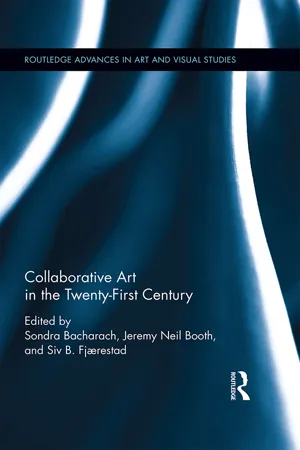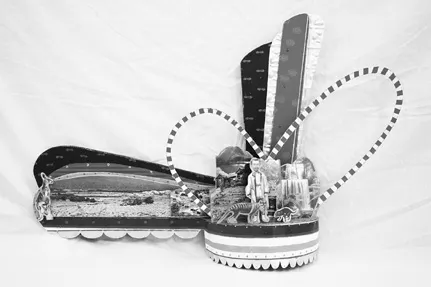![]()
Section III
Rethinking Collaborations
![]()
10
Sisterly Love
The Collaborative Art of Sisters
Louise R. Mayhew
It is said that individuals with sisters are happier and more optimistic, resulting from the tendency for sisters to encourage communication and family cohesion.1 The relationship of sisterhood (like brotherhood) is unique in that it predates, and outlasts, all other relationships among peers. It cannot be erased or undone in the same manner that divorce, fallings out, relocations, new jobs or professions cause the dissolution of couples, friends and colleagues. With this in mind, the following chapter introduces five sets of collaborating artist-sister groups.
The Strutt Sisters work with paint and collage to create dioramic assemblages inspired by Scandinavian design. Gabriella Mangano and Silvana Mangano perform as mirrored individuals, exploring gesture and the relationships between drawing, performance and film. Soda_Jerk combine audio and visual fragments from film, television, computer games and soundtracks to create experimental narrative remixes. Match Box Projects operate in public space, interacting with strangers whom they casually induct into the art world. The Sisters Hayes produce detailed, labor-intensive, multi-media works that demonstrate their diverse creative backgrounds.
The distinct assemblage, performance, remix, relational aesthetics and installation practices of these artist-sister groups also demonstrate a range of collaborative methods. These include collaboration as the palpable combination of skills and interests, a means to erase individuality and identity and a challenge to originality and solitary genius. Despite these differences, there are also common threads that bind these artist-sister groups. All of them are long-term and enduring, evidence of the commitment and enjoyment found in sisterly collaboration. They also share recurring themes of childhood, nostalgia, time travel, serendipity and mirroring.
The Strutt Sisters
The Strutt Sisters, Jennifer and Catherine, both studied visual art at university, pursuing similar interests in painting, assemblage and printmaking. A number of years later, they worked on their first piece together under the pressure of an exhibition deadline. The result, Dusting Thorn and the Cheatin’ Hearts (1995), convinced the sisters that “their combined efforts produced something far more interesting and complete than their individual art practices.”2 The pair have been working together since, signing their works simply ‘Strutt.’3
The Strutts’ practice incorporates elements of painting, collage and sculpture. Using fabric, paper, wood and aluminum, they create whimsical scenarios on miniature stages. In one work, from their Greener Pastures series, they envisage themselves in the garden, dressed in ball gowns and painting jelly. Other works depict scenes from nursery rhymes and international festivals. Serendipity and scrounging play a central role in their practice: all of their fabric and imagery – largely from the 1930s, ‘40s and ‘50s – is sourced from second-hand and charity shops.4 Although collage has previously been used, particularly in Dada, for political and social commentary, the Strutts employ collage to create an enjoyable viewing experience. Gallery Director, Damian Minton, describes their work as providing “moments of sheer theatrical delight and sensory pleasure.”5
The sisters have a clear working process. Starting with a sketch and the selection of colors and proportions, Catherine focuses on construction while Jennifer specializes in painting. This recognition of each other’s strengths, and the division of tasks, enables the sisters to create works that would not be possible without each other. Jennifer explains, “they would fall apart without Catherine and they wouldn’t look any good without me.”6
Collaborative theorist Charles Green identifies counter-cultural influences as “conducive to collective or group creation”, noting that the Boyle Family, Anne and Patrick Poirier, and Helen Mayer and Newton Harrison, were involved in the Rock music scene, Hippy Trails, the Peace Movement, consciousness-raising groups and alternative education.7 For the Strutts, an upbringing in their parents’ touring bush-band, Coalbrook Ceilidh, could be seen as similarly conducive to collaboration. Involvement in a band requires teamwork, cooperation and acknowledgment of shared creativity. It was also while touring that they began their habit of visiting opportunity shops and collecting second-hand items to use in their earlier, solo, art practices.8
Perhaps due to the sisters’ long-term working relationship, their closeness as twins or their shared sense of synesthesia, the duo has a distinctive visual style. Signature style is normally associated with one artist’s identifiable aesthetic technique. Susan Sundell and Nina Castelli Sollins describe collaborating artists who simulate the practices of individuals as ‘metaartists.’ They write “working in an art world accustomed to value art as the expression of a single, powerful, and original ego,” long-term collaborators who have no separate individual practices, “operate as metaartists.”9 Sundell and Castelli Sollins continue: “They practice a kind of cooperative individualism; their works possess the qualities of originality and particularity of style that characterize the twentieth-century artist.”10 This singularity is reinforced by the Strutts’ singular signature Strutt. Collaboration, for the Strutts, is a handy method for achieving more and improving their output, rather than a political comment on, or deliberate questioning of, the definitions of artist, authorship and originality. “We wish we were triplets”, says Catherine, “we could do with a third pair of hands.”11
Gabriella Mangano and Silvana Mangano
Gabriella Mangano and Silvana Mangano use both their full names when referring to their collaborative practice, signaling a desire to be recognized as two, distinct, individuals. Paradoxically, they are the only sisters to feature their relationship in their art, exploiting their visual similarity for the purpose of doubling and mirroring.
Gabriella and Silvana both studied drawing at the Victorian College of the Arts. Before they began collaborating, Silvana recalls, “There were times I would walk into Gabriella’s studio and think: ‘Is that my drawing? I could have drawn that!’ But no, it wasn’t. It was something I imagined I could have drawn.”12 The discovery of “similar ideas and themes” in their work, combined with the isolation of studio-based practice, prompted the pair to collaborate.13 Since 2001, the sisters have investigated identity, portraiture, gesture and communication in a series of films that draw on the conceptual language of drawing. Using their arms in languid, sweeping and dance-like movements, they liken their bodies to mark-making implements and identify film as a surface to be marked. Tania Doropoulos describes them as using their bodies and gesture “to draw in space.”14
The Manganos work predominantly in black and white, accompanied by minimal props, costumes and backdrops; prompting comparison to the work of Italian neo-realist filmmakers.15 In most works they appear together, cooperatively undertaking a simple, unspoken task. In those where only one sister appears on screen, the camera – and by extension the viewer – takes the position of the other sister, implying the presence of both sisters even though only one is seen.
Drawing 1 (2001) and if…so…then (2006) show the sisters standing face to face, drawing one another in a series of automatic movements. These skirt between choreography and intuition, demonstrative of a sort of ‘pre-verbal language’.16 In Absence of evidence (2008), the sisters sit back to back, divided by a tall thick wall. They take turns slowly guiding a billowing length of clean, white paper as it undulates and retracts from above. Falling Possibilities (2009) sees one sister standing behind the other, their hands engaged in a captivating reworking of cats cradle; twisting, tangling and untangling themselves in a length of tape. As the exchange becomes more rapid, the tape is repeatedly broken until only one small segment remains. The film then plays in reverse and the damage is undone. Between Near and Far (2008) and Time Lapse 1, 2 and 3 (2009) place the sisters in a wide, unknown landscape, engaged in childlike activities: tossing a bundle of tape to one another, swinging from a tree and exploring the land in a manner akin to ‘dawdling.’17
Matching outfits and mirrored actions present the twins as doubles; provoking curator Victoria Lynn to raise “the question of whether their representation is that of two halves of one whole, two of the same, or, indeed, two different entities.”18 The sisters argue that the “importance of being a twin is exaggerated by others,” with Gabriella explaining that the intention of their costumes is to “erase personalities and characters” in order to “emphasize the movement and motion of the drawing itself.”19 Robert C. Hobbs suggests that we expect artists to “conform to our idea of uniqueness, to differentiate themselves from the common crowd.”20 The Manganos relationship as identical twins – like the Strutts and the Shedlezkis – sets them apart from the ‘common crowd’, influencing the reception and interpretation of their practice. With their similar hairstyles, outfits and coordinated movements it is impossible to watch their films and not consider this relationship as integral to their work.
While visually and conceptually minimal, the Manganos’ art is engaging and evocative. Geraldine Barlow writes, “in the deliberate stillness of these works, the smallest, most subtle movement is enormously powerful.”21 The sisters’ withdrawn engagements provoke an uneasy sense of voyeurism, a sense of overexposure or a private performance made public.22 The gentle manipulation of film: speeding up, slowing down, reversing and mirroring movements, makes their actions “appear as if under water” or in a dream-sequence, further establishing a nontraversable distance between the viewer and the twins in their secretive, insular and pre-verbal world.23
Soda_Jerk
Soda_Jerk introduce their practice with a statement from George Orwell: “Whoever controls the past controls the future, whoever controls the present controls the past [sic].”24 Via visual and audio remixes, their practice engages with popular culture constructions of history; considering issues such as time, power, authority and ownership. Their name, ‘Soda_Jerk,’ which refers to a profession concerned with mixing, reflects their decision to work exclusively with existing material, reframing and recontextualizing the ‘found’ word or film fragment, while literally ‘underscoring’ the tendency for remix to intercept and interrupt.25
Although Soda_Jerk officially formed in 2002, Dan and Dominique recognize their collaboration as stretching back to their early teens, when they first used a video camera to ‘swede’ the movie Heathers. This was followed by a decade of ‘mucking around with equipment.’26 Technological know-how and theoretical engagement – with education and research backgrounds in art history and remix culture – are demonstrated in the pair’s knowing engagement with the history of remix, appropriation and related cultural phenomena. This includes theories and practices as distinct as: Situationist détournemont, Afrofuturist cultural theory and the improvisational similarities between remix, jazz and dj turntablism. The sisters explain, “improvisation is very much at the core of the way that we work. Because every shot and sound that we use must be ‘found’ we cannot predetermine the narrative of our video projects.”27
Soda_Jerk’s first epic, Pixel Pirate II: Attack of the Astro Elvis Video Clone (2002–2006), combines over 300 audio and visual samples to construct a biblical/action hero/romantic battle starring Elvis and the pixel pirates vs. Moses and his Copyright Commandments. Astro Black (2007) connects the cosmic philosophy and cultural politics of jazz musician Sun-Ra with the masters of hip-hop. Works in The Dark Matter Cycle (2005 onwards) (Figure 10.2) rely on the sad lives of child stars, including River Phoenix and Judy Garland, staging a meeting between their younger and older selves in order to produce a collision between cinematic fantasy and lived reality.28 Sentimentality, nostalgia and melancholy are invoked in these investigations of celebrity, tragedy and death.29
The sist...

